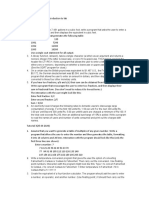excel
Uploaded by
lkishomy02excel
Uploaded by
lkishomy02'exportExcel()
'Try
'Dim xlApp As New Microsoft.Office.Interop.Excel.Application
'Dim xlWorkBook As Microsoft.Office.Interop.Excel.Workbook
'Dim xlWorkSheet As Microsoft.Office.Interop.Excel.Worksheet
'Dim misValue As Object = System.Reflection.Missing.Value
'Dim i As Integer
'Dim j As Integer
'xlApp = New Microsoft.Office.Interop.Excel.Application
'xlWorkBook = xlApp.Workbooks.Add(misValue)
'xlWorkSheet = xlWorkBook.Sheets("sheet1")
'If xlWorkBook Is Nothing Then
' MsgBox("")
'End If
'For i = 0 To DataGridView1.RowCount - 2
' For j = 0 To DataGridView1.ColumnCount - 1
' For k As Integer = 1 To DataGridView1.Columns.Count
' xlWorkSheet.Cells(1, k) = DataGridView1.Columns(k -
1).HeaderText
' xlWorkSheet.Cells(i + 2, j + 1) = DataGridView1(j,
i).Value.ToString()
' Next
' Next
'Next
'xlWorkSheet.SaveAs("F:\vbexcel.xlsx")
'xlWorkBook.Close()
'xlApp.Quit()
'releaseObject(xlApp)
'releaseObject(xlWorkBook)
'releaseObject(xlWorkSheet)
'MsgBox("You can find the file F:\vbexcel.xlsx")
'Catch
'End Try
'Dim xlApp As Microsoft.Office.Interop.Excel.Application
'Dim xlWorkBook As Microsoft.Office.Interop.Excel.Workbook
'Dim xlWorkSheet As Microsoft.Office.Interop.Excel.Worksheet
'Dim misValue As Object = System.Reflection.Missing.Value
'Dim i As Integer
'Dim j As Integer
'xlApp = New Microsoft.Office.Interop.Excel.Application
'xlWorkBook = xlApp.Workbooks.Add(misValue)
'xlWorkSheet = xlWorkBook.Sheets("sheet1")
'xlWorkSheet.Columns.AutoFit()
'For i = 0 To DataGridView1.RowCount - 2
' For j = 0 To DataGridView1.ColumnCount - 1
' xlWorkSheet.Cells(i + 1, j + 1) = _
' DataGridView1(j, i).Value.ToString()
' Next
'Next
'xlWorkSheet.SaveAs("C:\vbexcel.xlsx")
'xlWorkBook.Close()
'xlApp.Quit()
'releaseObject(xlApp)
'releaseObject(xlWorkBook)
'releaseObject(xlWorkSheet)
'Dim fnam As String = "Export"
'Using std As New SaveFileDialog
' std.Title = "Save As"
' std.OverwritePrompt = True
' std.FileName = fnam
' std.DefaultExt = ".xlsx"
' std.Filter = "Excel workbook(*.xlsx)|"
' std.AddExtension = True
' If std.ShowDialog() = DialogResult.OK Then
' xlWorkSheet.SaveAs(std.FileName)
' xlWorkBook.Close()
' xlApp.Quit()
' releaseObject(xlApp)
' releaseObject(xlWorkBook)
' releaseObject(xlWorkSheet)
' MsgBox("Successfully Export!", MsgBoxStyle.Information)
' End If
'End Using
'MsgBox("You can find the file C:\vbexcel.xlsx")
You might also like
- Libreria:: 'Exportamos Los Caracteres de Las ColumnasNo ratings yetLibreria:: 'Exportamos Los Caracteres de Las Columnas3 pages
- EVO Payroll Finance Report with auto save year and month wiseNo ratings yetEVO Payroll Finance Report with auto save year and month wise5 pages
- Export and Save Worksheets As New Workbook With VBA CodeNo ratings yetExport and Save Worksheets As New Workbook With VBA Code5 pages
- Excel Scripts Examples: Visit: For QTP InformationNo ratings yetExcel Scripts Examples: Visit: For QTP Information6 pages
- Apostila de Formulas, Funções e Macros PDFNo ratings yetApostila de Formulas, Funções e Macros PDF227 pages
- Sensitivity: LNT Construction Internal UseNo ratings yetSensitivity: LNT Construction Internal Use1 page
- Form Pengisian Nilai 1. Buat Tabel KHS Seperti Berikut IniNo ratings yetForm Pengisian Nilai 1. Buat Tabel KHS Seperti Berikut Ini7 pages
- Vb6 Membuka Tabel Access Dalam Bentuk ExcelNo ratings yetVb6 Membuka Tabel Access Dalam Bentuk Excel9 pages
- VA10800/VA10820 ARM Cortex - M0 Based Processor Programmers GuideNo ratings yetVA10800/VA10820 ARM Cortex - M0 Based Processor Programmers Guide151 pages
- MP Online Examination Unit 1 MCQ'S: SAJ MPMCQNo ratings yetMP Online Examination Unit 1 MCQ'S: SAJ MPMCQ20 pages
- Thrissur District Labour Contract Co-Operative Society Limited No. R. 13589 Door No: 7/505, NR - Konchery Road, P.O. M.G Kavu, ThiroorNo ratings yetThrissur District Labour Contract Co-Operative Society Limited No. R. 13589 Door No: 7/505, NR - Konchery Road, P.O. M.G Kavu, Thiroor2 pages
- A Robotic Automatic Assembly System Based On Visio100% (1)A Robotic Automatic Assembly System Based On Visio19 pages
- Project 1name - Excel Activities in Email Automation - People - EmailNo ratings yetProject 1name - Excel Activities in Email Automation - People - Email4 pages
- Rebalancing Shared Mobility-On-Demand Systems: A Reinforcement Learning ApproachNo ratings yetRebalancing Shared Mobility-On-Demand Systems: A Reinforcement Learning Approach7 pages
- Belsee Aftermarket Tesla Style Screen Android 11No ratings yetBelsee Aftermarket Tesla Style Screen Android 112 pages
- ShopSmart - An Innovative Shopping Trolley For Safe DistancingNo ratings yetShopSmart - An Innovative Shopping Trolley For Safe Distancing6 pages

























































































